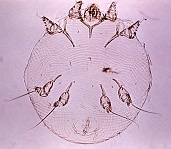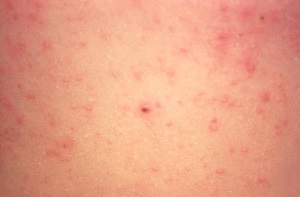Scabies is an infectious disease of the skin caused by Sarcoptes scabiei var. hominis. The infestation spreads easily from person to person, causing a rash and severe itching as an allergic reaction to the mites and their feces. This is one of the most common skin infections with an estimated annual number of cases exceeding 200 million across the globe. While the disease is particularly common in overcrowded and impoverished places in tropical areas, group living facilities, such as nursing care homes, are also at risk of infection. The World Health Organization (WHO) designated scabies as a neglected tropical disease (NTD) in 2017.
Causes of Infection
Parasitic adult scabies mites (Sarcoptes scabiei var. hominis) burrow into and proliferate in the top layer of the skin, spreading to others primarily through skin-to-skin contact. The risk of transmission increases with the level of infestation. While “common scabies,” in which the number of scabies mites is relatively small, poses no risk of infection as long as direct skin-to-skin contact is avoided, mites are likely to be found in the clothes and bed linens used by patients who have “crusted scabies”, who tend to host a huge number of mites. Adult mites (female body length reaching 400 μm) dig so-called “scabies burrows” into the top layer of the skin, laying 2 to 3 eggs per day for approximately 2 months. The eggs hatch in 3–4 days, and the hatched mites exit the burrow, wander on the skin, and develop into adult mites in approximately 2 weeks.
Pathogen: scabies mite (Sarcoptes scabiei var. hominis)

Symptoms
Although there is an asymptomatic period immediately after infection, the mites multiply within 4–6 weeks, causing intense itching and a rash which develop as an allergic reaction to the mite and its feces. The itch tends to worsen at night. Red skin bumps (papules) and thin crooked lines, called "scabies burrows" are observed on the skin. These symptoms appear over the whole body except the head, including the fingers, arms, legs, belt area, female breast and male genitalia. While only 10 to15 adult mites are present on the skin surface in “common scabies”, thousands to millions of mites are found over the entire body including the head in “crusted scabies”, which tends to be common in people with suppressed immune systems. While thick crusted plaques are observed in wide areas of the skin, there tends to be less itching in the case of crusted scabies. Crusts shed from the skin contain a lot of scabies mites, which can potentially be a source of infection. Patients with either type of the scabies often develop secondary infection with bacteria, which is considered to be a risk factor for renal failure. Secondary infection with bacteria in patients with crusted scabies can lead to death due to sepsis and other diseases.

Diagnosis and Treatment
Diagnostic Methods
Diagnosis is often possible based on typical clinical symptoms, and a definitive diagnosis is made by the detection of scabies mites. Microscopic examination of tissues collected from the lesions are used to detect the mites, eggs, and eggshells, which should be repeated several times as their detection may be difficult when the number of mites is low.
Treatment
Although oral and topical medications are used to kill scabies mites, treatments should be repeated as they do not kill the eggs. Topical medications, such as permethrin, malathion, benzyl benzoate and sulphur agents, should be applied on the entire body. Although oral ivermectin is also used for treatment, but it should not be used by pregnant women and children weighing less than 15 kg. In a case of secondary infection with bacteria, treatment with appropriate antimicrobials is needed, and topical corticosteroid ointments or oral antihistamines are used for treating itching.
Prevention
Preventing group infection through early detection and intervention is very important. The mites usually die after 2 to 3 days after away from human skin. Effective prevention measures include avoiding skin-to-skin contact with people experiencing itchy papules, providing treatment to all persons living with identified patients, and washing the clothes of the infected person with hot water and drying them in the sun or a dryer, or sealing clothes in an airtight plastic bag for a few days to a week. As large number of mites are found in crusted scabies, rooms used by a patient with the disease should be cleaned thoroughly.
Regions at High Risk of Infection
Scabies is one of the most common skin diseases and accounts for a significant proportion of dermatological conditions in developing countries. While scabies is found in all countries, children in many resource-poor tropical areas are likely to have high infection rates, and prevalence can be as high as 50%.
Estimated Number of Infected People
According to the WHO, more than 200 million people worldwide are estimated to be affected.
Estimated Number of Deaths
The number of deaths from scabies has not been estimated.
References (Accessed: November 28, 2023)
World Health Organization (WHO) - Scabies
Centers for Disease Control and Prevention (CDC) - Scabies
National Institute of Infectious Disease, Japan - Scabies (only in Japanese)
MSD Manual Professional Version (msdmanuals.com) - Scabies
